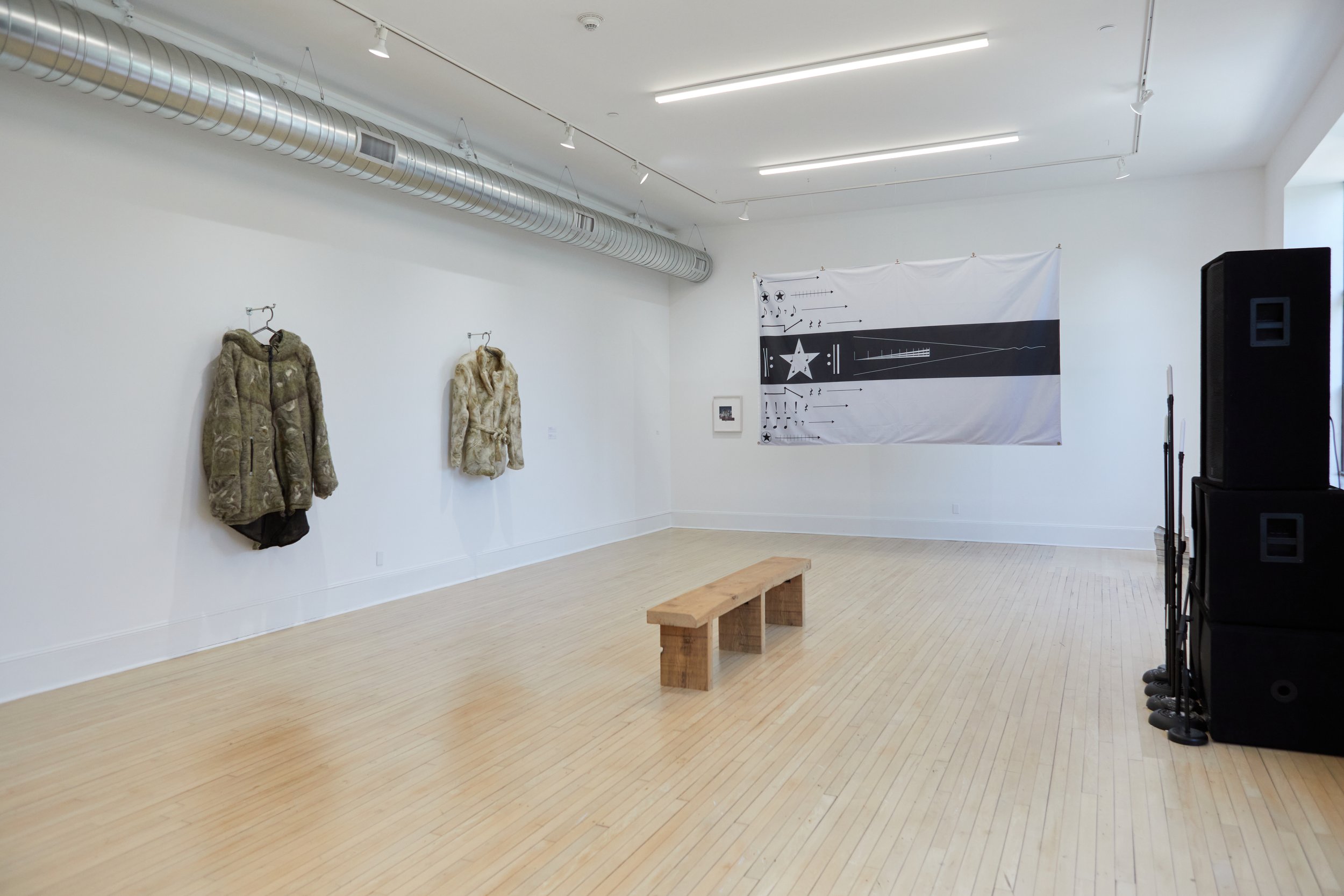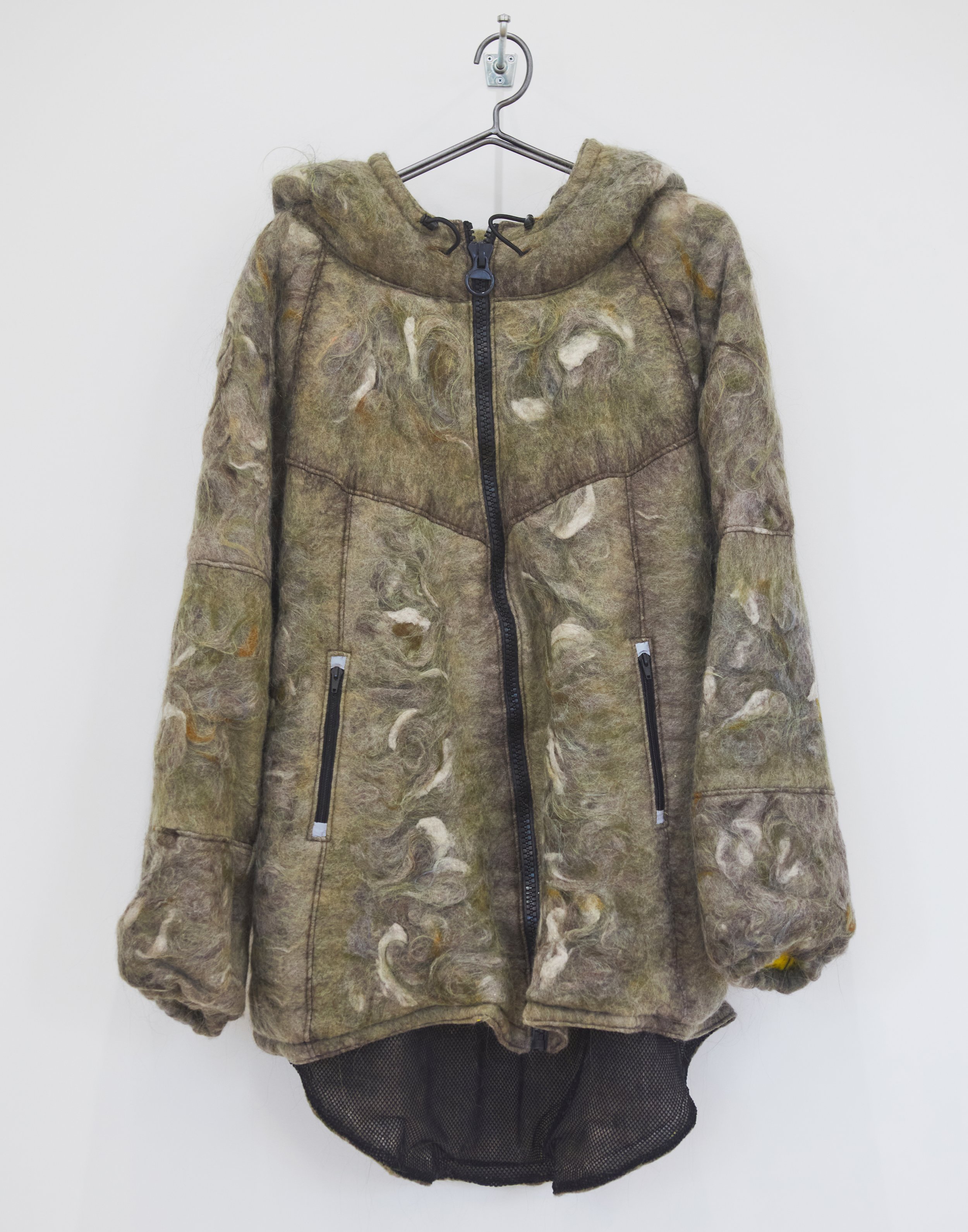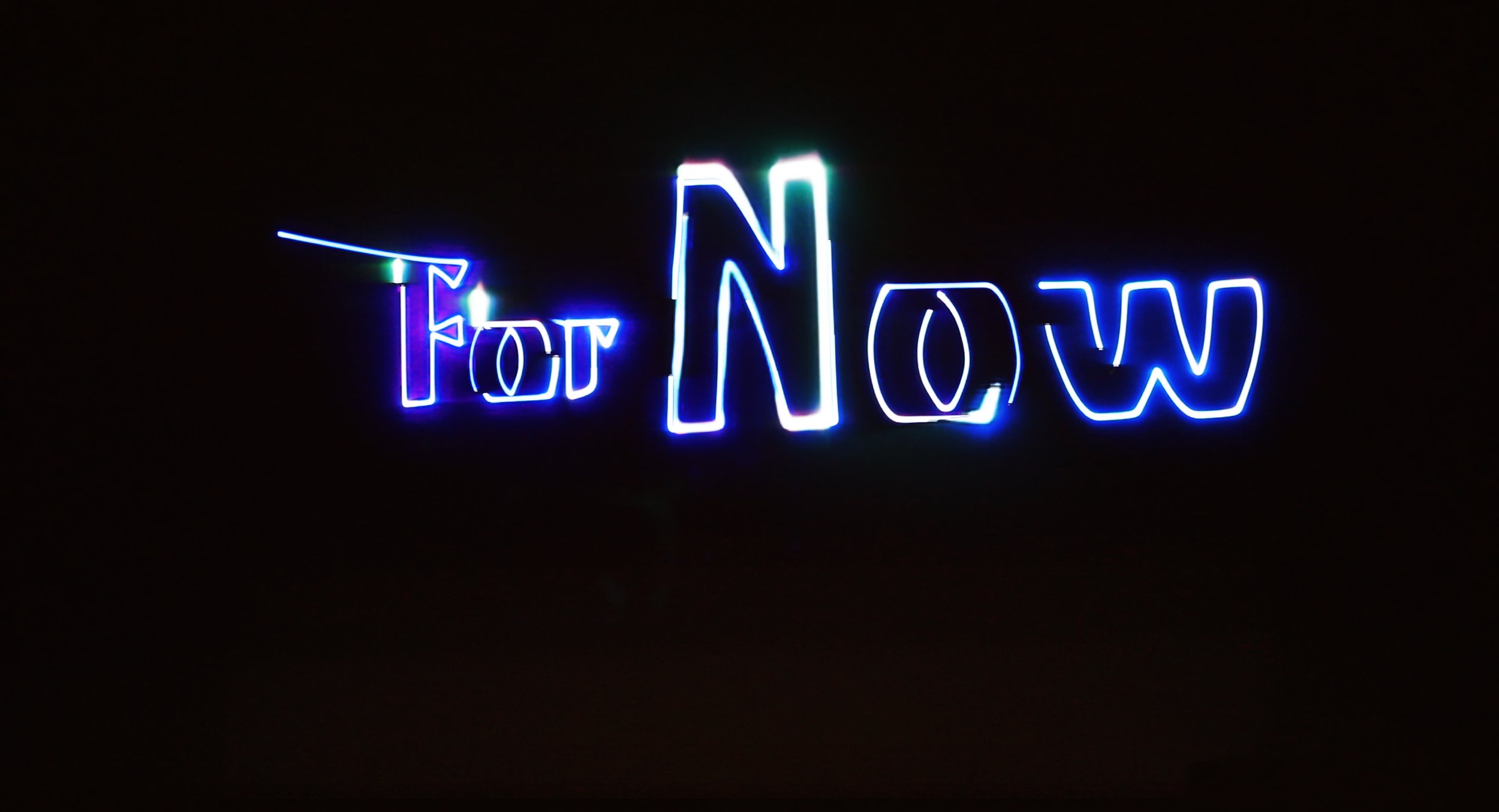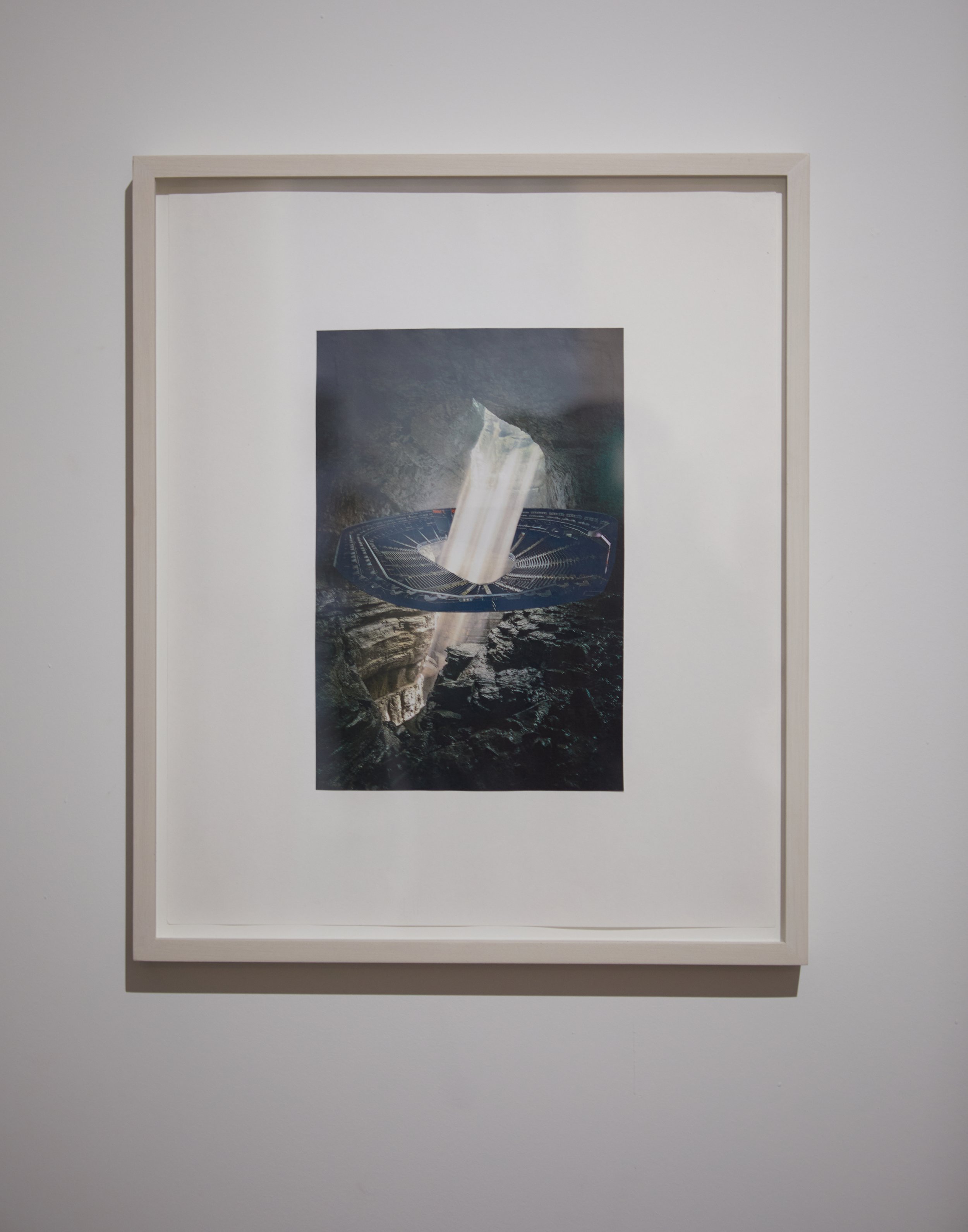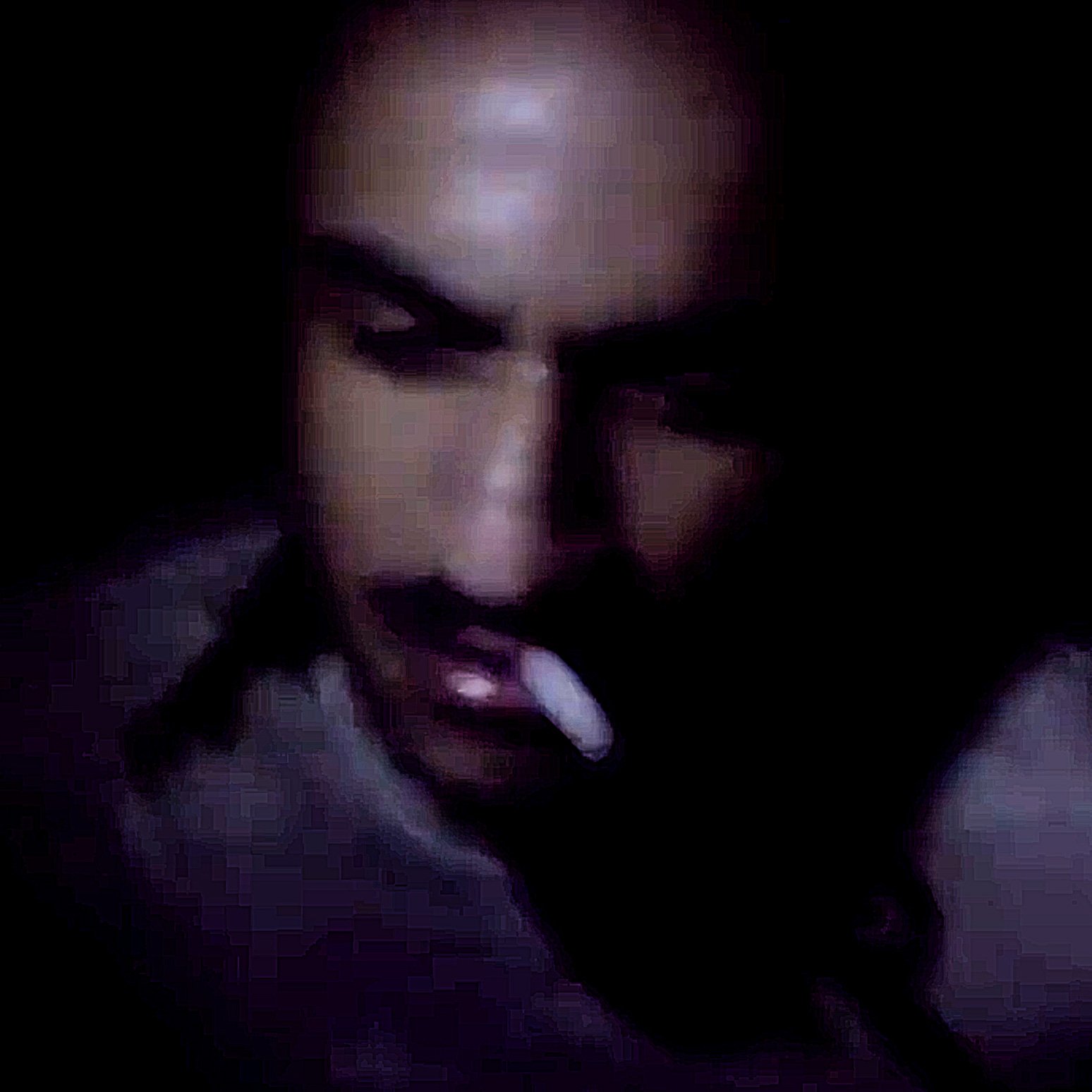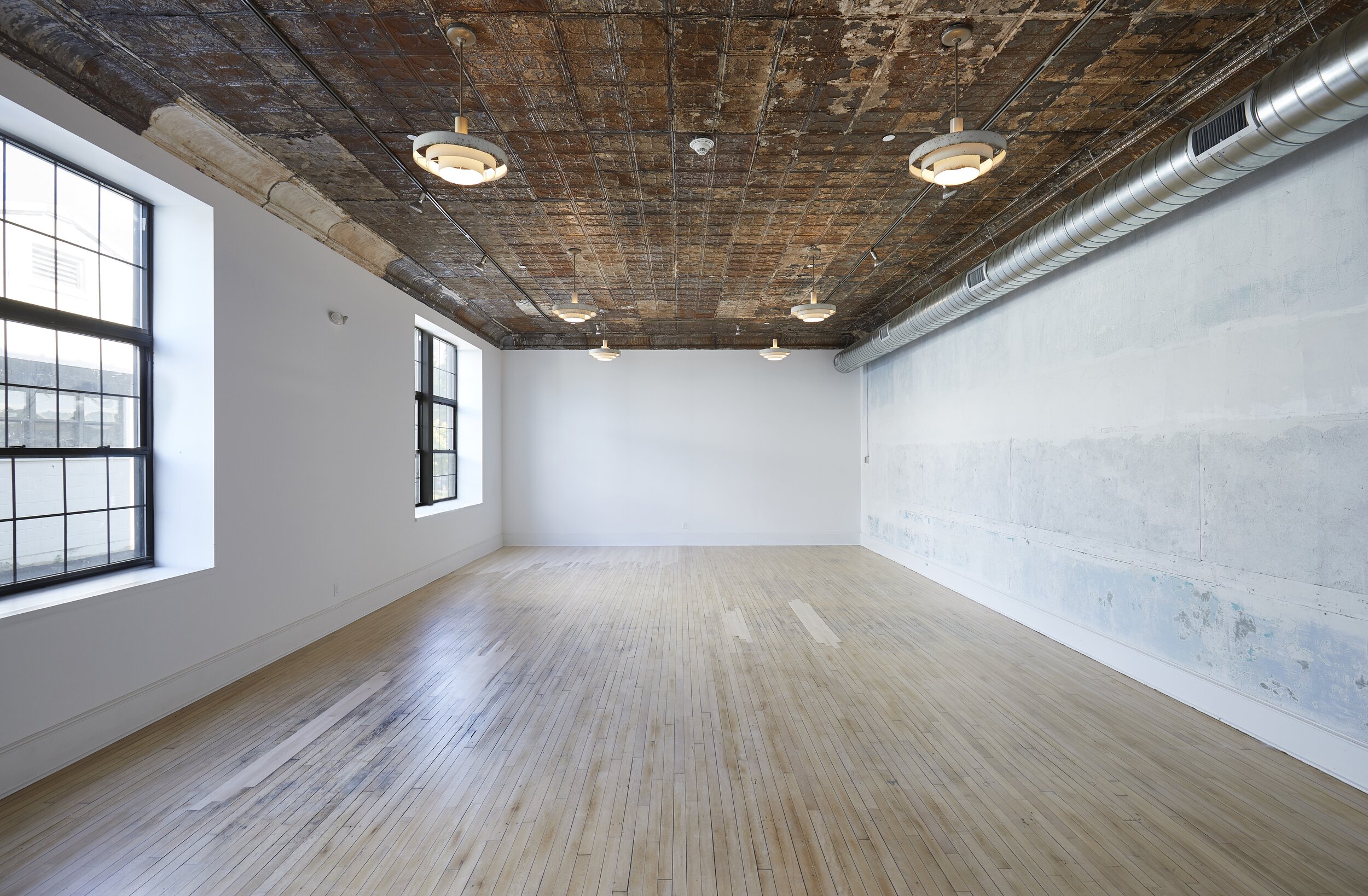
GALLERY 2, THEATER, GARDEN
SIGNALING
Fri. 9 Sep. – Sun. 11 Dec. 2022
Vivian Caccuri, Raven Chacon, Nikita Gale, Jacqueline Kiyomi Gork, L’Rain, Nicole Miller, and Jeremy Toussaint-Baptiste
Performances: on September 10, for the opening reception, KinoSaito will present ticketed performances by Dawuna and Jeremy Toussaint-Baptiste with Dreamcrusher; On October 22, Raven Chacon, L’Rain, and Toussaint-Baptiste will perform. (L’Rain will be an artist in residence at KinoSaito during the exhibition.) See below for more information.
Curated by Alexander Provan
To signal is to convey meaning through a gesture or expression—to communicate directly and artlessly, with the clarity of a traffic light or siren. In the realm of online posting and positioning, however, signaling has come to stand for the sharing of generic, fashionable statements, as opposed to genuine convictions, much less complicated opinions. Behind this new, negative definition is the strange expectation that every utterance somehow relay the speaker’s true meaning, or even true identity. But why should signaling be either sincere or performative, reflecting selfhood or groupthink? Why should people always reveal (or even know) what they mean and who they are, rather than expose or conceal themselves based on who is listening and what is at stake?
Signaling focuses on artists who are scrutinizing the terms through which people address and understand (or evade and misread) one another—and insisting on recognition while refusing identification. The exhibition suggests that the dichotomy between candor and posturing is false, and that purposeful communication calls for people to continually recast themselves based on the messages being crafted and audiences being cultivated. Through works in a range of media, Signaling emphasizes the advantages of moving between disclosure and deflection, inclusion and exclusion, especially for people whose expressions have, historically, been derided and suppressed (while also being exploited as entertainment and property).
Many of the artists in Signaling are preoccupied with the conditions that enable certain bodies, voices, and identities to merge, however fleetingly and partially. For Now (2018), a laser animation by Nicole Miller, toggles between the synaesthetic spectacle of an arena concert and the quivering projection of a private mantra: the eponymous phrase, a reminder of the ephemerality of collectivity (and individuality). Jacqueline Kiyomi Gork presents sculptures in the form of oversize attire fabricated from sound-absorbing materials and imbued with signifiers of identity: a kimono speaks to national inheritance, two jackets evoke punk-adjacent subcultures. But the definition of the artist remains elusive, thanks to the variety of garments meant to cloak Gork’s figure. In … and Drive (Far Away) (2022), Jeremy Toussaint-Baptiste turns an unmarked cop car into a means of camouflage and connection: obscured by tinted windows, the Louisiana-born artist plays a chest-rattling composition through custom subwoofers, appropriating the notorious Crown Vic to amplify (rather than police) the frequencies of Gulf Coast rap.
Toussaint-Baptiste’s mobile sculpture hails people who recognize themselves in the bass, but also those who have not been conditioned to do so. Whether viewers feel comforted, overwhelmed, or put off by the sound, the artist invites them not only to stand and listen but to sit beside him, in the passenger seat, as he performs the work, manipulating windows and doors like keys on a woodwind. Music often appears in “Signaling” as a model for navigating between insiders and outsiders, authenticity and abstraction, self and persona. But even as the artists in the exhibition seek the freedom of communicating as—and to whom—they wish, they hold up the promise of becoming someone different when addressed as such, when communing with others or tuning in to unfamiliar frequencies.
KinoSaito thanks Empty Gallery, Kristina Kite Gallery, François Ghebaly, 56 Henry, Martos Gallery, and Seth Stolbun for supporting “Signaling.”
Performances
Photo of Dawuna, courtesy of the artist.
Dawuna and Jeremy Toussaint-Baptiste
Sat. 10 Sep. 2022
For the opening of Signaling, Jeremy Toussaint-Baptiste performed a composition for an unmarked police car that he has turned into a sound system and instrument: … and Drive Far Away (2022), his contribution to the exhibition. (The work will be installed in KinoSaito’s garden throughout the exhibition.) After the performance, Toussaint-Baptiste spoke about the work and his relationship to bass, Gulf Coast rap, car-audio culture, and policing.
To conclude the evening, the musician, Dawuna, performed with a band in KinoSaito’s theater. Dawuna’s music is ethereal and quietly ecstatic, but rooted in the moral quandaries and emotional turbulence of daily life. Their debut, the self-produced Glass Lit Dream (2020), balances ambient soundscapes and stirring melodies, industrial artifacts and gospel-inflected meditations on desire and alienation. Shifting between genres and moods while anchored by his delicate, mesmeric voice, Dawuna’s music reflects the pursuit of self-definition without sacrificing the freedom to inhabit multiple styles and personas. The Guardian called Glass Lit Dream a “masterpiece”; Boomkat described the debut as “astonishing, smoldering R&B”; and Bandcamp Daily hailed the record as an “underground hit” in which “genres pioneered by Black musicians … seamlessly intertwine with darker ambient sounds and liquid synths.” At KinoSaito, Dawuna was joined by Brian Davenport and Noella Mugerwa Byenkya.
This event was co-presented by the magazine Triple Canopy, which is edited by Alexander Provan, the curator of “Signaling.” Beverages for this event were graciously provided by Grimm Ales and Hiatus Tequila.
Photo of L’Rain, courtesy of the artist.
Raven Chacon, L’Rain, and Jeremy Toussaint-Baptiste
Sat. 22 Oct. 2022
For this series of performances, KinoSaito presented the premiere of Raven Chacon’s American Ledger No. 3 (2020), a composition devoted to the journalist and anti-lynching campaigner Ida B. Wells. Like many of the Pulitzer Prize-winning artist and composer’s works, American Ledger No. 3 is a graphic score to be interpreted, in this case, by an ensemble of vocalists. (American Ledger No. 3 includes a flag emblazoned with the score and a newsprint publication that connects Wells’s writing to contemporary police violence.)
The musician L’Rain performed solo and in a duo with her bandmate Ben Chapoteau-Katz. Eschewing the conventions that link genres to identities, expressions to experiences, L’Rain’s music ranges from propulsive, gospel-tinged pop to dense, sample-laden abstraction; from intimate, unadorned ballads to clattering, free-jazz-influenced improvisations. L’Rain, who was an artist in residence during the exhibition, had recently released Fatigue (2021), which the New York Times described as “truly amazing” and Pitchfork called “a graceful record whose wearied landscapes of synth, air horn, strings, and saxophone distill a suite of low moods—depression, regret, and fear—into resilience and hope.”
Jeremy Toussaint-Baptiste performed a composition for an unmarked police car that he has turned into a sound system and instrument: … and Drive Far Away (2022), his contribution to the exhibition. (The work will be installed in KinoSaito’s garden throughout the exhibition.) After the performance, Toussaint-Baptiste spoke about the work and his relationship to bass, Gulf Coast rap, car-audio culture, and policing.
This event is co-presented by the magazine Triple Canopy, which is edited by Alexander Provan, the curator of “Signaling.” Beverages for this event were graciously provided by Hiatus Tequila.
Works in the Exhibition
Vivian Caccuri
Oratório (Tidal Wave), 2017. Subwoofers, candles, microphone stands, amplifiers, and original sound composition. Variable dimensions. Collection of Pinacoteca de São Paulo. Donation from the Contemporary Art Patrons of Pinacoteca de São Paulo, through Associação Pinacoteca Arte e Cultura, 2019.
Caccuri, a Brazilian artist, often deals with the role of music in daily life, especially the performances and parties where communities gather—and relationships emerge from the mixing of sounds and traditions. Oratório (Tidal Wave) reflects Caccuri’s interest in musical rituals as sources of sociality and ecstasy, but also as targets of repression and forms of resistance. An altar constructed from subwoofers plays a bass-heavy composition, setting in motion the flames of candles held by microphone stands. Based on a fourth-century Christian hymn, Caccuri’s composition evokes the shift in Christian music toward the voice (so as to express the word of God)—and the rejection of bass and percussion as erotic, irrational. European colonizers brought this attitude to Brazil and elsewhere, fueling the denigration of Indigenous (and African) people, whose music was suppressed or banned. Oratório (Tidal Wave) is a meditation on that history as well as a manifestation of the power of bass to move and merge bodies, to enable transcendence.
Raven Chacon
American Ledger No. 3, 2020. Polyester flag and newsprint publication with graphic score. Variable dimensions. Courtesy of the artist.
Chacon, an artist and musician from Fort Defiance, Navajo Nation, often creates compositions in the form of graphic scores, trading traditional notation for visual symbols to be interpreted by performers, whether individually or collectively. The performance of these works tends to differ dramatically based on the players—who are free to engage in actions and expressions that do not involve instruments, but may nonetheless yield sonic effects—as well as the context and audience. In addition to utilizing his scores in performances, Chacon presents them as artworks, calling on viewers to interpret the symbols in much the same way as musicians: to consider how they are conditioned to speak and listen, how they might find a sense of common understanding—a common voice—beyond the conventions of communication. For “Signaling,” Chacon presents American Ledger No. 3, a composition devoted to the journalist and anti-lynching campaigner Ida B. Wells. The work appears as a flag with the score and a newsprint publication that includes additional instructions for performers and connects Wells’s writing to contemporary police violence. American Ledger No. 3 was debuted at KinoSaito on October 22.
Raven Chacon and Rob Thorne, Earth Mother/Father Sky, 2021. Digital video with sound, 30 min. 18 sec. Courtesy of the artists and Issue Project Room.
Raven Chacon and Candice Hopkins, Rift Transcription, 2020. Digital video with sound, 10 min. 7 sec. Courtesy of the artists and Bergen Kunsthall. Videography by D. E. Hyde. Commissioned by Joar Nango.
Raven Chacon and Cannupa Hanska Luger, Watȟéča :: Ch’iyáán Yiskáago, 2022. Digital video with sound, 21 min. 51 sec. Courtesy of the artists. Videography by D. E. Hyde and Ginner Dunnill, audio recording by Laura Ortman. Commissioned by 6 Moons Indigenous Concert Series.
These three videos document performances by Chacon and fellow Indigenous musicians from 2020 to 2022. In each video, Chacon performs at the West Mesa outside of Albuquerque, near Petroglyph National Monument—a site that is sacred to Native peoples, especially the Pueblo—in view of the three volcanoes that dominate the landscape. (The Pueblo’s history on the land is marked by glyphs on the rocks, which are believed to have been created by supernatural beings at the dawn of time, and to provide a link to the realm of ancestors and spirits.) The first video captures a pandemic-era collaboration with Rob Thorne, a Ngāti Tumutumu/Tainui composer and anthropologist, who played as the sun rose near his home in Oruaiti, Aotearoa (New Zealand), while Chacon did the same as the sun set in New Mexico, each capturing his perspective on video. In the second video, Chacon is joined by Candice Hopkins, a Carcross/Tagish First Nation curator and writer, both of whom don handmade costumes; the performance was inspired by a Sami drum inscribed with a landscape that depicts the setting of the ritual and notates the music to be played. The third video documents a collaboration between Chacon and Cannupa Hanska Luger, an artist of the Mandan, Hidatsa, Arikara, and Lakota tribes; Chacon manipulates dysfunctional electronics from his collection and Hanska Luger plays his own instrument-esque ceramic sculptures, with the musicality of the performance reflected in the performers’ gestures and sense of attunement, as much as in the liminal sounds being produced.
Nikita Gale
LOCKED LUNGS, 2021. Acrylic console, acrylic disc with locked groove, turntable, amplifier, speakers. 12 × 6 × 10 in. Collection of Seth Stolbun.
Gale often reflects on the dynamic between performers and spectators, and how each shapes the other, whether via the presentation of personas, composition of audiences, engineering of spectacles, or architecture of auditoriums. In LOCKED LUNGS, Gale captures the sound of someone inhaling and exhaling on a record with a locked groove, which causes the breathing to repeat for as long as the turntable is on. The work evokes the power and fragility of the human voice, and of the physical—and technological—means through which the body sounds. Transferring breath from one decaying medium to another, LOCKED LUNGS conveys the potential for the voice to resonate or be extinguished, to inspire others to engage in listening or suppression.
COLLAPSE I, 2021. Collage on paper. 17 × 14 in. Collection of Arty Nelson.
COLLAPSE II, 2021. Collage on paper. 17 × 14 in. Collection of Edwin Chan.
COLLAPSE IV, 2021. Collage on paper. 17 × 14 in. Collection of Vikram Ravikumar.
In the series of collages that includes these three works, Gale sketches out a vision of the history and future of spectatorship: images of the contemporary arenas where thousands gather for high-tech sound-and-light shows merge with those of ancient cave dwellings where communities huddled around fires to tell stories, aided by illustrations painted onto the walls. Rather than establish a lineage between disparate forms of ritual and entertainment, Gale indicates how individuals and societies are conditioned by the steady traffic between publicity and privacy, anonymity and intimacy. The collages also point to the reign of legibility as erasing the distinction between these realms, limiting the means through which people represent and understand themselves.
Jacqueline Kiyomi Gork
Sound Blanket No. 7, 2022. Hand-felted wool, human hair, synthetic hair with satin and mesh lining, and steel hardware. 59 × 59 × 7 in. Courtesy of the artist, Empty Gallery, and François Ghebaly.
Sound Blanket No. 9, 2022. Hand-felted wool, human hair, synthetic hair with satin lining, and steel hardware. 47 × 44 × 7 in. Courtesy of the artist, Empty Gallery, and François Ghebaly.
Sound Blanket No. 16, 2022. Hand-felted wool, cotton, synthetic hair, and armature. 82 × 82 × 4 in. Courtesy of the artist, Empty Gallery, and François Ghebaly.
Gork is interested in the systems that shape how people perceive and represent themselves, from the production of pop songs to the design of communication networks. Gork often uses sound to explore feedback loops: sets of inputs and outputs that respond to one another, continually changing in the process. The artist is particularly invested in the role of sound and music in enabling people to forge multifaceted, mutable identities, which may change (in substance or expression) depending on time and place, intent and audience. The sculptures in Gork’s ongoing Sound Blanket series take the form of oversize attire fashioned in part from sound-absorbing materials, which serve to dampen or deflect audio signals. Ranging from parkas to kimonos to bombers, the sculptures evoke aspects of identity—the kimono speaks to national inheritance, the jackets to punk-adjacent subcultures—while allowing Gork to elude definition, thanks to the variety of garments meant to cloak the artist’s figure.
Nicole Miller
For Now, 2018. Synthesizer-generated RGB laser animation with sound, 44 min. Variable dimensions. Courtesy of Kristina Kite Gallery.
Miller’s videos, sculptures, and multimedia installations address race, translation, and the politics of representation. Her work often invites viewers and listeners to engage with the bodies and voices of performers, especially people of color working in music and dance, from Michael Jackson to students learning to express themselves. Miller asks how these performers understand their own histories and form their own identities—and how audiences might empower them to do so, rather than buy into the degrading narratives and archetypes so often imposed by outsiders. Recently, Miller has employed a single, rapidly flickering laser beam to produce stirring, skeletal animations that shift between impressions of bodies, barrages of light, and fragments of text. In For Now, a synaesthetic spectacle that evokes an arena concert—an experience that hinges on the presence of an audience, the merging of individuals—is tempered by the recurrence of a private mantra: the eponymous phrase, a reminder of the ephemerality of collectivity (as well as selfhood). The movement of the laser beam is controlled by audio signals, with the mechanical translation of frequencies prompting the viewer’s effort to fix the onslaught of information so as to register an image, a message, a moment.
Jeremy Toussaint-Baptiste
… and Drive (Far Away), 2022. Mixed media sound installation and performance. Variable dimensions. Courtesy of the artist and Martos Gallery.
Toussaint-Baptiste, an artist as well as a performer and composer, is interested in how people represent themselves and relate to others through sound and music. He considers how some audiences are conditioned to appreciate and recognize themselves in particular sounds, such as the low-frequency bass that characterizes Gulf Coast rap, while others are trained to find the same frequencies repulsive or alienating. Toussaint-Baptiste employs subwoofers that emit tones so low that they are felt rather than heard, emphasizing the physical nature of sound and of the relationships formed through music. Growing up in the Gulf South, Toussaint-Baptiste was fascinated by the culture of customizing vehicles with tinted windows and deafening subwoofers, and his work often asks how people use such cars to simultaneously announce and conceal themselves.
For … and Drive (Far Away), Toussaint-Baptiste appropriates the notorious Ford Police Interceptor, the unmarked cop car that became ubiquitous in the 1990s and, as a result, shifted from a means of camouflage to a conspicuous sign of policing (and of the intimidation of communities of color through such signs). Originally used by police in Baton Rouge, where Toussaint-Baptiste was born (and where his grandfather served as a police official), the Crown Vic was given to the artist by Olivier Mosset, a painter who became known in the 1960s for exhibiting minimalist, geometrical canvases alongside custom cars and motorcycles. The exterior of the car has been painted burgundy with black squares that evoke Kazimir Malevich’s Black Square (1915), famous as the “zero point” of abstract painting—and recently discovered to have been inscribed by an unknown author with a racist statement about a “battle of negroes in a dark cave”. Toussaint-Baptiste installed ultra-low-frequency subwoofers in the trunk and a police-surplus sound cannon on the hood, turning the car into a sculpture and instrument: when activated by the artist, an audio composition is played through the speakers and manipulated via the opening and closing of windows and doors like keys on a woodwind (Toussaint-Baptiste’s sculpture also acts as a platform for working with fellow artists who are engaged with musical subcultures characterized by bass, and will be activated by several collaborators during the course of the exhibition). Visitors are invited to experience this performance from outside the car or by sitting in the passenger seat.
Before installing … and Drive (Far Away) at KinoSaito, Toussaint-Baptiste drove the car from Tucson, Arizona, to Richmond, Virginia, along I-10 and I-95, recording the trip—and the sounds emitted by the speakers—with a dash cam.
Biographies
Vivian Caccuri is an artist and musician living in Rio de Janeiro, Brazil. Her work centers on the physicality of music and the role of music in people’s daily lives. Caccuri has had solo exhibitions at A Gentil Carioca Gallery (Rio de Janeiro), Museu de Arte Contemporânea de Niterói (Rio de Janeiro), Kunsthal 44Møen (Denmark), and Galeria Leme (São Paulo). Her work has been recently been included in the Dhaka Art Summit, Kochi Muziris Biennale, Mercosul Biennial (Porto Alegre, Brazil), and in exhibitions at the High Line (New York City), Institute of Contemporary Art Miami, FACT (London), Serpentine Galleries (London), Museum of Contemporary Art of Detroit, Ming Contemporary Art Museum (Shanghai), and Pinchuk Art Center (Kiev). Caccuri’s works are part of the collections of the Pinacoteca do Estado de São Paulo, Museu de Arte Moderna do Rio de Janeiro, Pérez Art Museum (Miami) and Institute of Contemporary Art Miami.
Centennial Gardens is the duo of the New York City-based musicians Dreamcrusher and King Vision Ultra. The group’s debut, SPLIT (PTP), was released in 2021. Dreamcrusher is a moniker of the musician and artist, Luwayne Glass. Glass began Dreamcrusher in 2003 while living in Kansas as a means of self-discovery and release, and of addressing the experience of being queer and Black through various forms and personas, none of them static or stable. King Vision Ultra is an alias of the musician and artist, GENG PTP, founder of the collective Purple Tape Pedigree, which releases music and publications as well as organizing community gatherings and actions. Since 2017, King Vision Ultra has produced music that deals with the relationship between memory, archives, self-actualization, and trauma.
Raven Chacon is a composer, performer, and artist from Fort Defiance, Navajo Nation. As a solo artist, Chacon has exhibited, performed, or had works performed at the Whitney Museum of American Art’s 2022 Biennial (New York City), Los Angeles County Museum of Art, Renaissance Society (Chicago), REDCAT (Los Angeles), Vancouver Art Gallery, Haus der Kulturen der Welt (Berlin), SITE Santa Fe, Ende Tymes Festival, and the Kennedy Center (Washington, D.C.). As a member of the group Postcommodity from 2009 to 2018, Chacon co-created artworks that were presented at the Whitney Biennial, documenta 14, Carnegie International 57, and, in the case of the two-mile-long installation Repellent Fence (2015), on the border of the United States and Mexico. Since 2004, he has mentored over three hundred Native high school composers in the writing of new string quartets for the Native American Composer Apprenticeship Project (NACAP). Chacon won the Pulitzer Prize for music in 2022 and is the recipient of awards and fellowships from United States Artists, Creative Capital, the Native Arts and Cultures Foundation, the American Academy Berlin, the Bemis Center, and the Pew Center for Arts and Heritage.
Dawuna is the alias of Ian Mugerwa Byenkya, a musician raised in Kenya and Virginia and now living in New York City. Dawuna’s first album, Glass Lit Dream (2020), was recorded in Mugerwa Byenkya’s apartment and self-released; after circulating online and being lauded by fans and critics, the record was remastered and rereleased by the London label O___o?. The Guardian called Glass Lit Dream a “masterpiece”; Boomkat described the debut as “astonishing, smoldering R&B”; and Bandcamp Daily hailed the record as an “underground hit” in which “genres pioneered by Black musicians … seamlessly intertwine with darker ambient sounds and liquid synths.” Dawuna has performed at Blank Forms, the Noguchi Museum, Performance Space New York, and Printed Matter, among other venues.
Dreamcrusher is a moniker of the New York City-based musician and artist Luwayne Glass. Glass began Dreamcrusher in 2003 while living in Kansas as a means of self-discovery and release, and of addressing the experience of being queer and Black through various forms and personas, none of them static or stable. Glass describes Dreamcrusher as “nihilist queer revolt musik.” Dreamcrusher’s work is at once personal and abstract, revealing and antagonistic; performances and recordings shift between genres while subjecting the characteristic elements—melodies, beats, instrumentation—to distortion until the point of transformation. Dreamcrusher has released dozens of recordings with labels such as PTP, Fire Talk, and Corpus, as well as on Bandcamp and other online platforms. Dreamcrusher is also a member of the duo Centennial Gardens with King Vision Ultra.
Nikita Gale lives and works in Los Angeles. Gale uses concrete, metal, light, and sound to create sculptures and installations that deal with themes of invisibility and audibility, crafting relationships between performers and spectators, infrastructures and ruins. Gale has had solo exhibitions at Chisenhale Gallery (London), LAXART (Los Angeles), 52 Walker (New York City), 56 Henry (New York City), California African American Museum (Los Angeles), and MoMA PS1 (New York City). Gale has received a FOCAFellowship (2021) and Rema Hort Mann Foundation Emerging Artist Grant (2017). Gale is a contributing editor at Triple Canopy and recently co-hosted the magazine’s podcast Omniaudience, which is devoted to how people listen and make themselves heard.
Jacqueline Kiyomi Gork is an artist living in Los Angeles. Gork’s work is rooted in an intuitive sensitivity to systems of feedback and sound in the built environment, and often utilizes architectural and sonic materials to modulate how people experience and navigate space. Gork has had solo exhibitions at François Ghebaly (New York City), Empty Gallery (Hong Kong), VSF Gallery (Los Angeles), 356 Mission (Los Angeles), Western Front (Vancouver), the Lab (San Francisco); the artist’s work has recently been included in the Hammer Museum’s “Made in LA” (Los Angeles) and in exhibitions at Sculpture Center (New York City), SFMoMA (San Francisco), and V-A-C Foundation (Moscow).
L’Rain is the moniker of the Brooklyn-based musician, Taja Cheek. She released her debut, self-titled album in 2017, and Fatigue (Mexican Summer) in 2021. Her work has been praised by the New York Times, the New Yorker, New York Magazine, Pitchfork, Artforum, Fader, and the Wire, among other publications. In recent years, she has played festivals around the world and toured with artists such as Animal Collective and Sharon Van Etten.
Nicole Miller is an artist based in California. Her videos, sculptures, and multimedia installations often address race, translation, and the politics of representation, and present active viewing as a tool for reconstituting personal histories, bodies, and identities. Miller has had solo exhibitions at the Kemper Art Museum (St. Louis), Marfa Ballroom (Marfa, Texas), Centre D’art Contemporain Geneva, Kunst Werk Berlin, the California African American Museum (Los Angeles), and Kristina Kite Gallery (Los Angeles). Her work has recently been included in exhibitions at the Studio Museum in Harlem (New York City), the Hammer Museum, Musée d’art contemporain de Lyon, and SFMoMA (San Francisco). Miller is a recipient of a Rome Prize, Guggenheim Fellowship, William H. Johnson Prize, and Louis Comfort Tiffany Prize. Her work is in the collections of the Los Angeles County Museum of Art, Hammer Museum, and SFMoMA.
Alexander Provan is a writer and the editor of Triple Canopy. He recently produced and co-hosted Triple Canopy’s podcast Omniaudience, which is devoted to how people listen and make themselves heard, and in 2018 released the sound work Measuring Device with Organs. Provan’s work as an individual has been exhibited and performed at the Hessel Museum of Art, Bard College (Annandale-on-Hudson, NY), the 14th Istanbul Biennial, Museum Tinguely (Basel), the 12th Bienal de Cuenca, and the New Museum (New York City); his work with Triple Canopy has been presented at the 2014 Whitney Biennial, Kunsthalle Wien (Vienna), Tai Kwun Center for Heritage and Arts (Hong Kong), Museum of Contemporary Art Chicago, RISD Museum (Providence), and the Hammer Museum (Los Angeles). Provan is the recipient of a Creative Capital | Andy Warhol Foundation Arts Writers Grant and has been a fellow at the Vera List Center for Art and Politics (New York City), as well as a resident at Para Site (Hong Kong) and Tai Kwun.
Jeremy Toussaint-Baptiste is a New York-based artist, composer, and performer. His work considers errant relations that thrive across subjectivities. He has recently had solo exhibitions at the Institute for Contemporary Art at Virginia Commonwealth University (Richmond), Human Resources (Los Angeles), and Berlin Atonal (Berlin). He is represented by Martos Gallery (New York City). He has presented visual and performance work at MoMA PS1 (New York City); Performance Space New York; the Brooklyn Museum; the Kitchen (New York City); Issue Project Room (New York City); the Studio Museum in Harlem; and the Philadelphia Museum of Art. Toussaint-Baptiste is a founding member of the performance collective Wildcat!. He has been an artist in residence at Issue Project Room, the Bemis Center, the Jerome Foundation Airspace Residency at Abrons Arts Center, and the Rauschenberg Foundation; he has been named a Camargo Foundation Core Program Fellow and received a Bessie Award for Outstanding Music Composition and Sound Design.

